
Brightest planets of the night sky put on season-long spectacle this winter
In addition to hosting one of the best meteor showers of the year, this winter we'll see gatherings of the brightest planets in the night sky.
With the long nights and still air, Winter is an excellent time to stargaze. It's the planets that we need to keep our eyes on this winter, though, as they form up into spectacular alignments and conjunctions throughout the season.
Here's what to look for in the night sky for Winter 2021-2022.
AT A GLANCE
Dec 21 - Winter Solstice
Dec 21 - Jupiter, Saturn, Venus line up in the SW sky after sunset
Dec 22 - Peak of the Ursids (minor meteor shower)
Dec 31 - Jupiter, Saturn, Mercury, & Venus in SW sky after sunset
Jan 2 - Perigee New Moon (closest of 2022)
Jan 3 - Jupiter, Saturn, Venus, Mercury & Moon in SW sky just after sunset
Jan 3-4 - Peak of the Quadrantids (best winter meteor shower)
Jan 3-4 - Earth at Perihelion (closest to the Sun for 2022)
Jan 4-5 - Crescent Moon near Jupiter & Saturn in SW sky after sunset
Jan 10 - Mercury highest in the evening sky
Jan 17 - Full Wolf Moon
Jan 29 - Venus, Mars & thin crescent Moon in SE sky before sunrise
February - Venus, Mars & Mercury form a triangle in the SE sky before sunrise
Feb 9 - Venus reaches its greatest brightness
Feb 16 - Full Snow Moon
Feb 27 - Saturn joins Venus, Mars, Mercury & Moon in the SE sky just before sunrise
March - Saturn, Venus & Mars form a triangle in the SE sky before sunrise
Mar 17-18 - Full Worm Moon
Mar 20 - Spring Equinox
Visit our Complete Guide to Winter 2022 for an in-depth look at the Winter Forecast, tips to plan for it, and much more!
WINTER SOLSTICE
On December 21, at 10:53 a.m. EST, the Sun will reach its southernmost point in the skies of Earth. In the northern hemisphere, this will mean the Sun will reach its lowest point in our sky, marking the first day of Winter. In the southern hemisphere, it will reach its highest point, signalling the start of Summer.
This will be the shortest day of the year and thus the longest night. How much daylight and nighttime you see depends on how far north or south you live. Kingsville, Ont (the southernmost community in Canada) will see 9 hours, 06 minutes and 43 seconds of sunlight on December 21. Meanwhile, Iqaluit, NU, will have less than half that, with only 4 hours, 20 minutes and 9 seconds of daylight. Farther north, the Sun will have already set for last time this year and will only rise again in early 2022.
METEOR SHOWERS
Starting off this season, the Ursid meteor shower will peak on the night of December 21-22. Typically a fairly weak shower, the Ursids usually produce around 10 meteors per hour. With its source — comet 8P/Tuttle — having rounded the Sun in late August of this year, though, it could produce about 25-30 meteors per hour on the night of the peak.
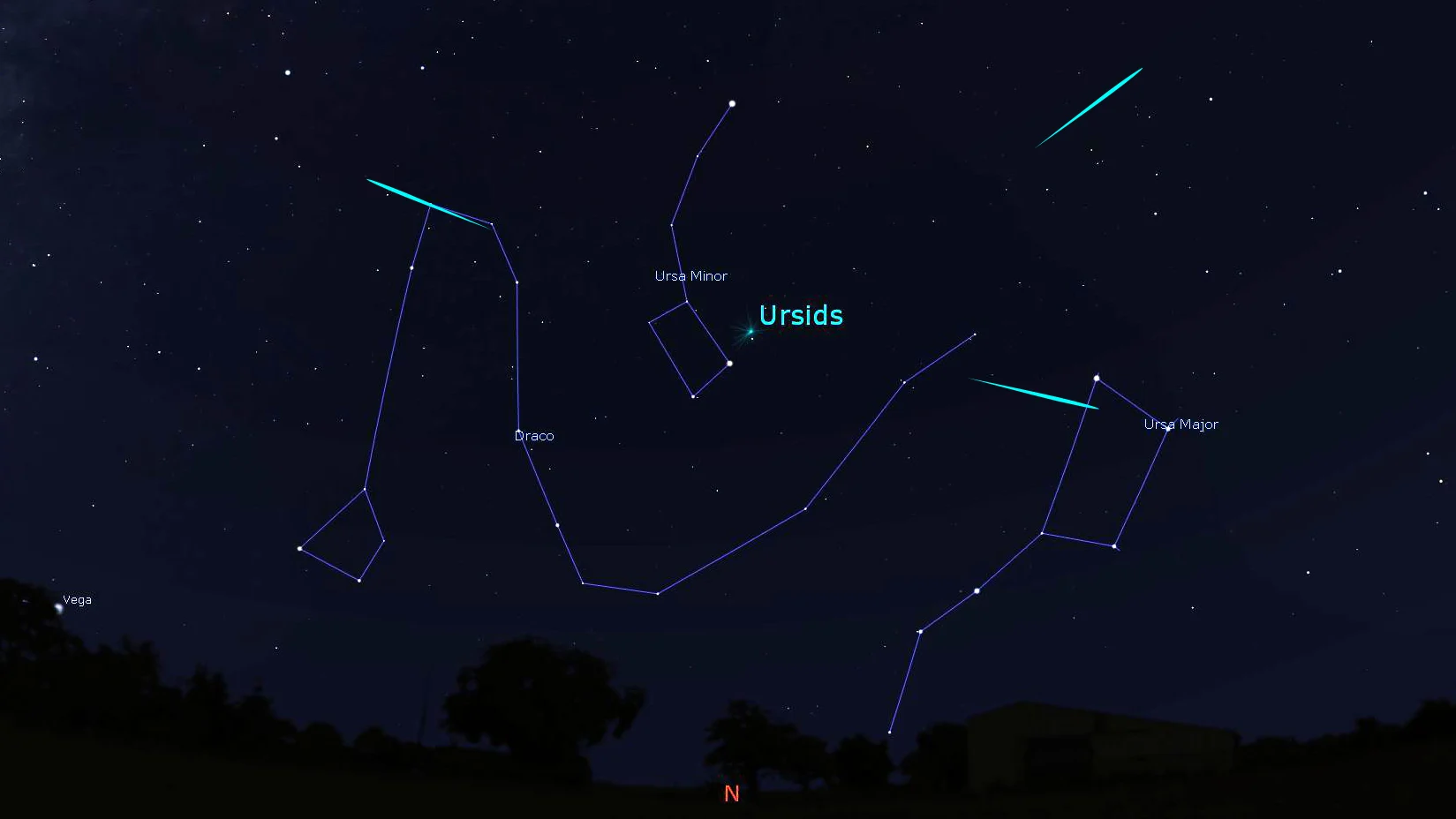
The Ursid meteor shower is named due to its radiant being positioned close to the constellation Ursa Minor, aka The Little Dipper. Credit: Stellarium/Scott Sutherland
However, this shower is peaking just three nights after the Full Moon. Thus, the competing light of the Gibbous Moon in the sky will wash out the dimmer meteors, reducing the number we will see.
We won't have long to wait for a better opportunity, though. The best of the winter meteor showers (and one of the three best meteor showers of the year) occurs in the nights following New Years' — the Quadrantids.
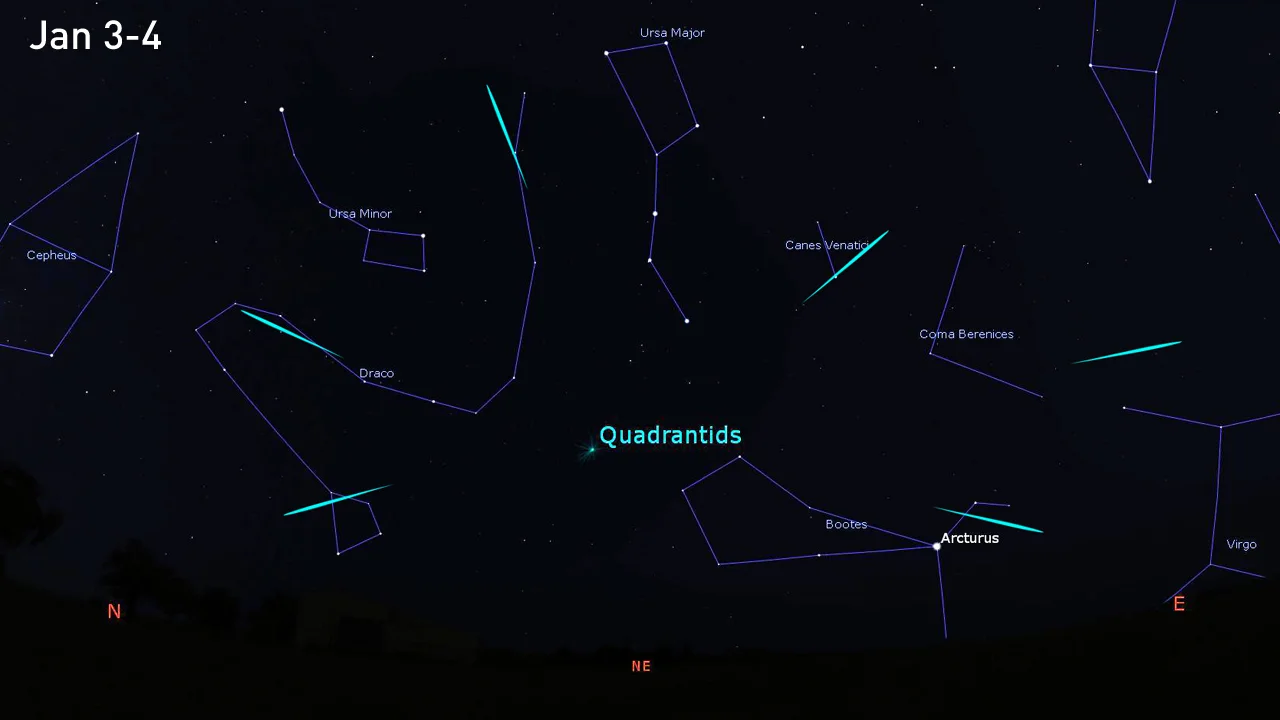
The radiant of the Quadrantids, in the NE sky, on the night of January 3-4, 2022. Credit: Stellarium/Scott Sutherland
Quadrantid meteors originate from an object known as 2003 EH1, which may be an 'extinct comet' — a comet that has lost all of its ice, leaving behind an asteroid that flies along the original orbit. That makes it one of only two or three meteor showers to originate from a rocky body! During this shower, the meteors are caused by tiny bits of debris from this asteroid plunging into the upper atmosphere. There, they compress the air in their path, heating that air until it glows.
According to the International Meteor Organization, this year's Quadrantids peak will occur on the night of January 3. This is perfect timing for the meteor shower, as it is only one night after the New Moon. Thus, there will be very little competition in the sky, allowing viewers to see more meteors.
The exact number of meteors we see from the Quadrantids can vary, year to year. Typically, though, it produces around 120 per hour or up to two per minute. The IMO says that there's even the chance of this particular shower having two peaks, a smaller one followed by the main one.
Keep reading for our guide to stargazing and meteor shower watching, below.
EARTH AT PERIHELION
This event isn't so much something to see, as it is something to simply experience.
Each year in early January, Earth reaches a point in its elliptical orbit known as perihelion — the planet's closest distance to the Sun for the entire year.
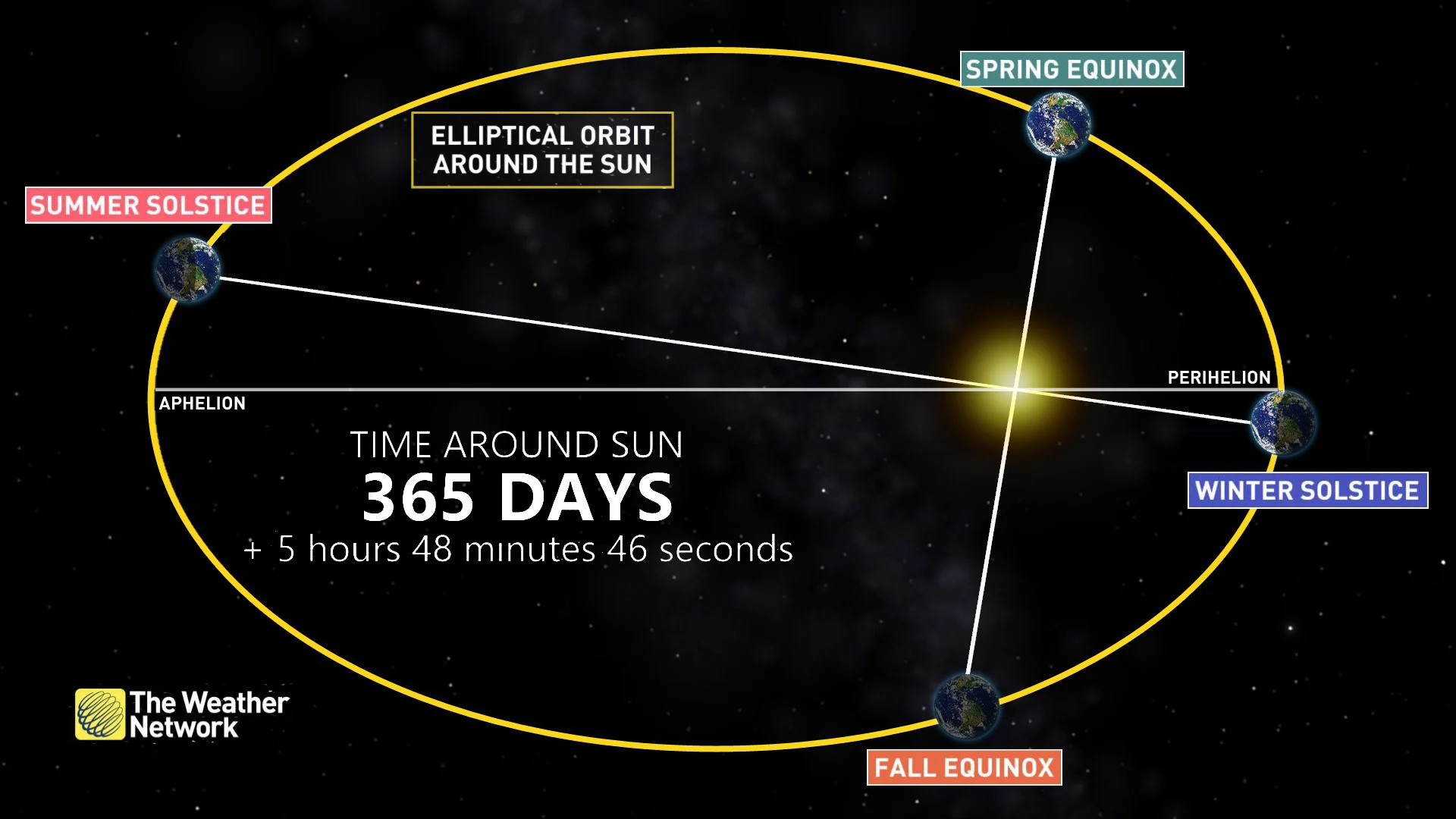
Earth's orbit around the Sun, noting the Solstices, Equinoxes and the timing of perihelion and aphelion. The image is not to scale, and the ellipse of Earth's orbit has been exaggerated. Credit: NASA/Scott Sutherland
If you want to mark the event, even if it's just to pause for a short break, it occurs at exactly 6:55 a.m. UTC on January 4, 2022. That's:
3:25 a.m. January 4 NST
2:55 a.m. January 4 AST
1:55 a.m. January 4 EST
12:55 a.m. January 4 CST
11:55 p.m. January 3 MST
10:55 p.m. January 3 PST
At that exact moment, Earth will be 147,500,475 kilometres away from the Sun. That's close to 12,000 km closer than perihelion 2021, and it's the closest we'll come to the Sun until January 2038.
Will you feel anything when this occurs? Not specifically from the astronomical event, but it will still be pretty cool to mark the moment when it happens!
THE PLANETS AND THE MOON
The brightest planets in our night sky will spend much of the upcoming season grouped together for us.
Right off the top of the season, on the night of December 21, look for Jupiter, Saturn, and Venus to be lined up in the southwest sky in the hours after sunset.

Jupiter, Saturn, and Venus to the SW after sunset on December 21. Credit: Stellarium
We'll continue to see this alignment for the remainder of December. Then, towards the end of the month, the trio will be joined by Mercury.
Watch for the closest planet to the Sun to become visible above the southwestern horizon around December 28, just after sunset. December 31 will probably be the best night to see it.
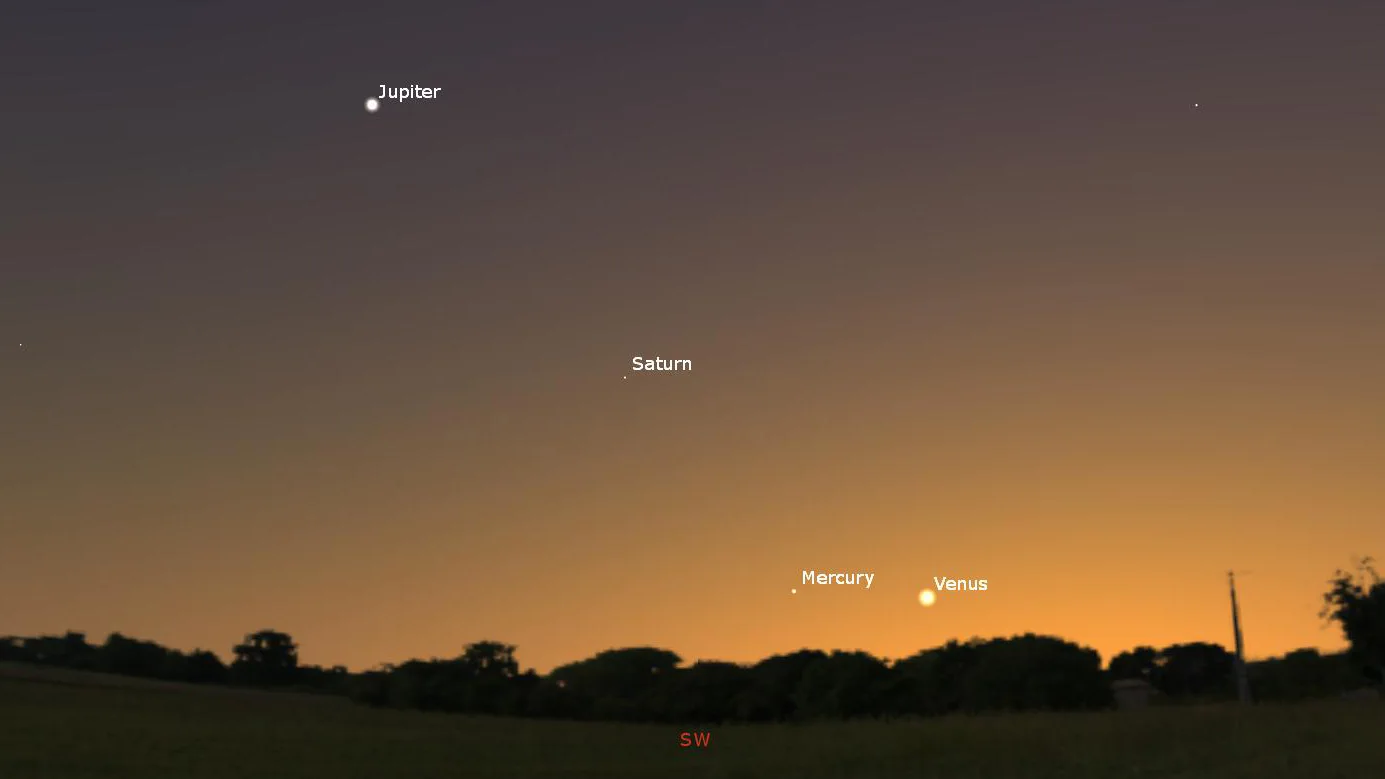
It will be a bit of a challenge to see it all. Still, if you look very closely to the southwest right after sunset in early January, you may see these four celestial objects joined by a very thin Crescent Moon.
On the 4th and 5th of January, watch for that thin Crescent Moon to pass by Saturn and then Jupiter.
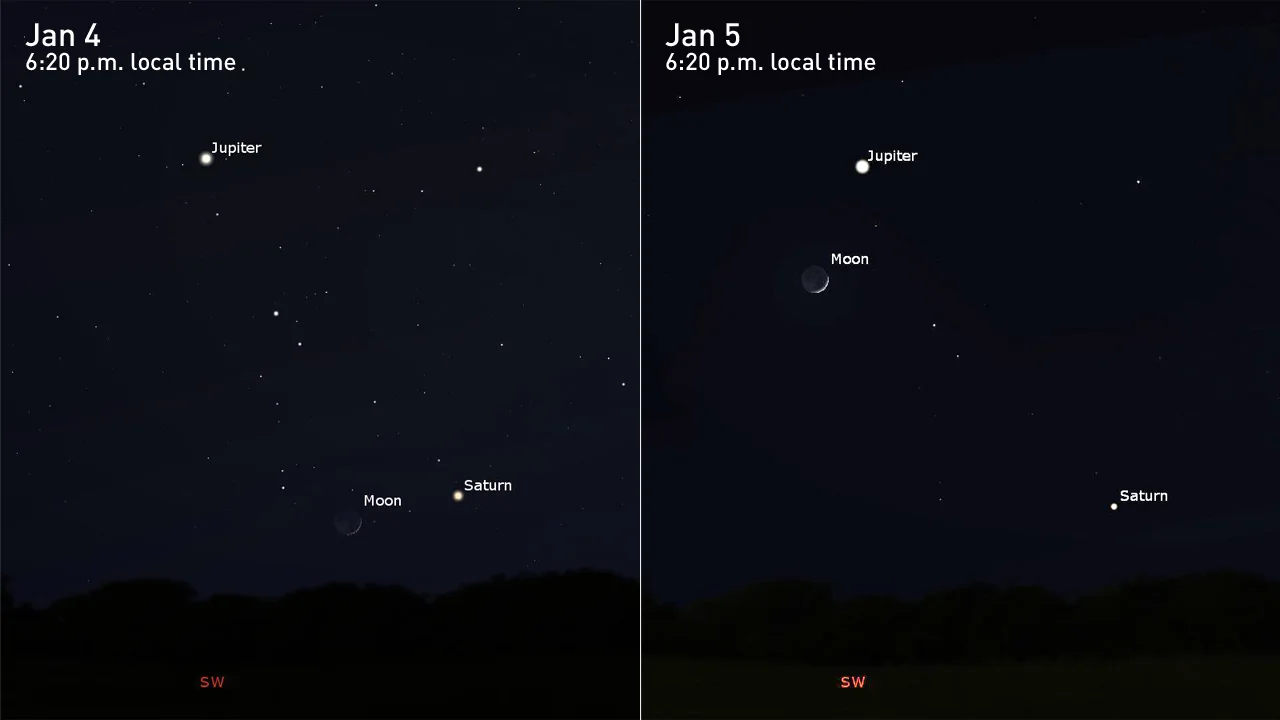
The Moon, Saturn and Jupiter, on the nights of January 4 and January 5, 2022. Credit: Stellarium/Scott Sutherland
Then, towards the end of January, keep a lookout for Venus and Mars to team up in the predawn sky. The pair will be joined by the Moon on January 29 and January 30.
Starting in early February, Mercury will form a triangle with Venus and Mars. The 9th to the 12th are likely the best nights to see this. This is when the three planets are closest together and farthest from the horizon before the Sun rises.
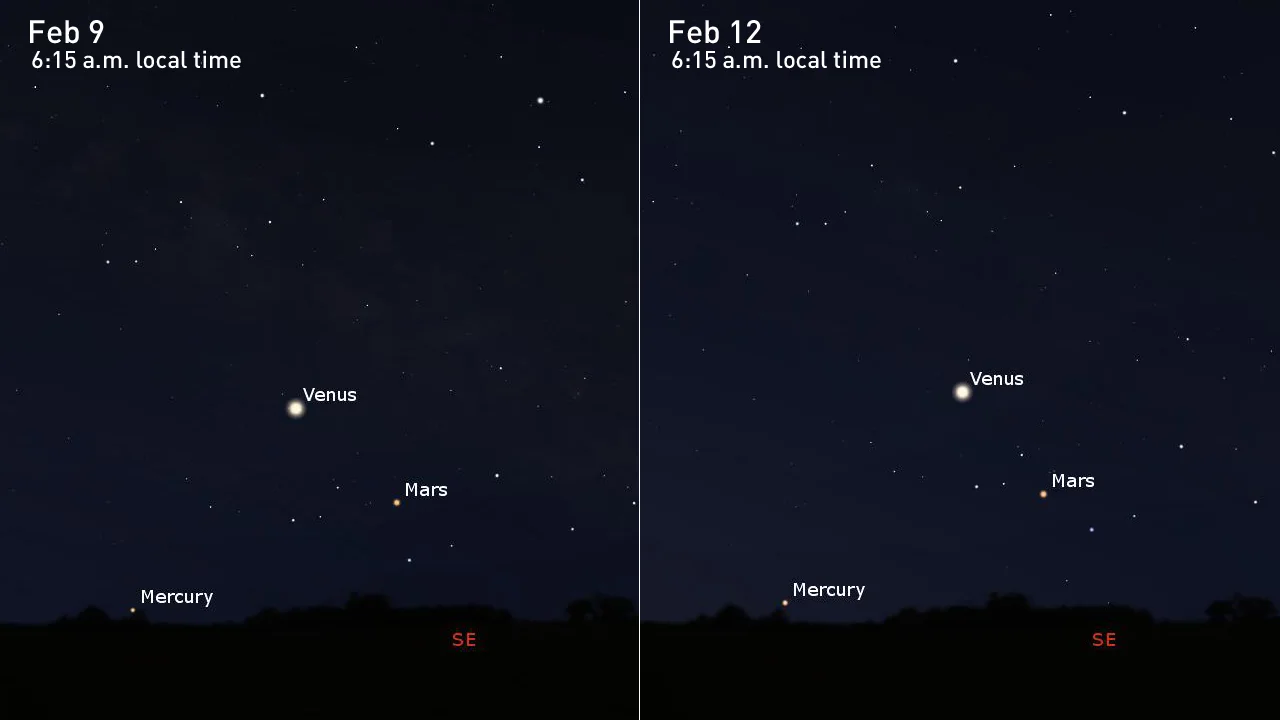
Mercury, Venus, and Mars above the southeastern horizon on the mornings of February 9 and 12, 2022. Credit: Stellarium/Scott Sutherland
These three will remain visible in the hours just before sunrise for the rest of the month. However, Venus and Mars will pull farther away from Mercury during that time.
In the final days of February, watch for Saturn to pop up above the horizon near Mercury, and the Crescent Moon will join the group as well.

Mercury will be lost to the brightening dawn in the days after, but Saturn will replace it in the triangle with Venus and Mars for the rest of the season.
This trio will be best seen from the 12th to the 15th when they are closest together.
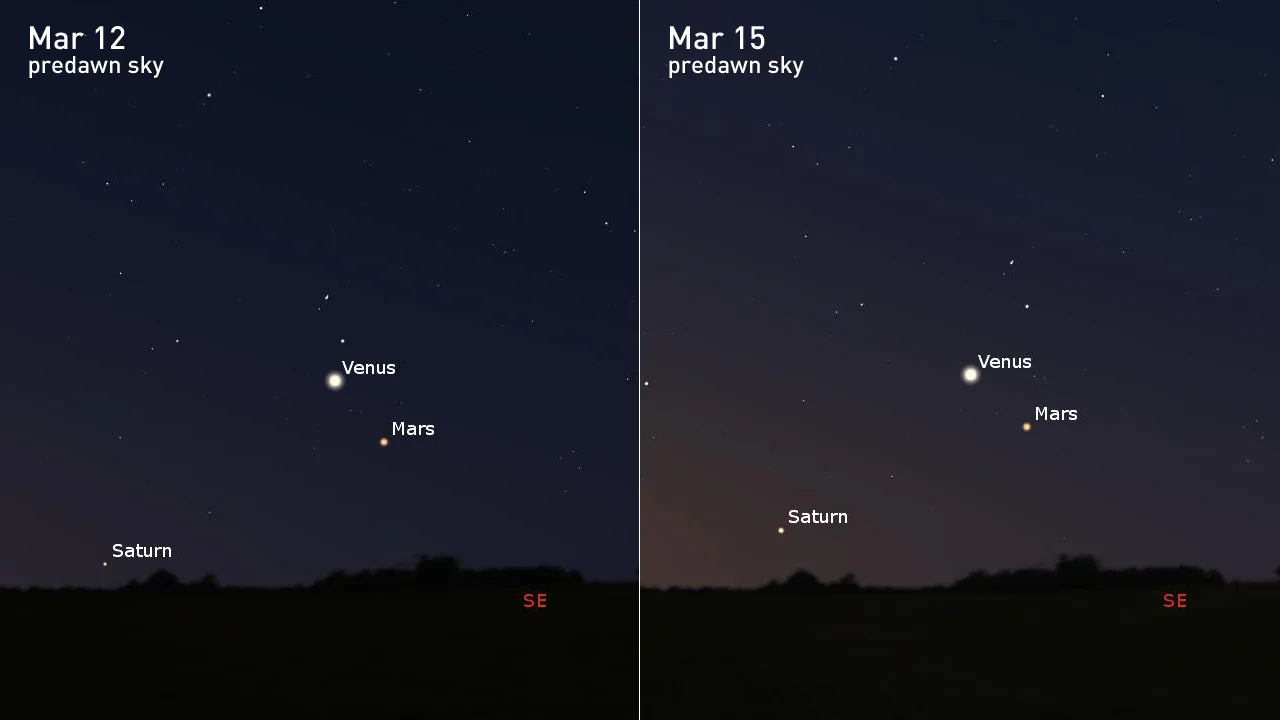
Venus, Mars, and Saturn in the predawn sky on March 12 and March 15, 2022. Credit: Stellarium/Scott Sutherland
While the Crescent Moon joins these planetary conjunctions and alignments from time to time, the Full Moons of Winter are on their own for the season. We'll see the first Full Moon of 2022, the Wolf Moon, on January 17, the Full Snow Moon will cross the sky on the night of February 16, and the Full Worm Moon occurs on the night of March 17-18.
Even though we won't see it happen, the closest New Moon of the new year occurs during the day on the 2nd of January. So closely timed with Earth's closest pass around the Sun, this will likely produce some exceptionally high tides.
SPRING EQUINOX
At precisely 11:27 a.m. EDT on March 20, the Sun will appear to cross Earth's celestial equator, ushering in Spring in the northern hemisphere. In the southern hemisphere, it denotes the start of Fall.
TIPS FOR STARGAZING AND METEOR SHOWERS
Given how polluted our night skies are with urban light, it is no longer a simple matter to step outside and gaze up at the stars. It's even more difficult to watch an event such as a meteor shower. Follow the tips below, though, and you won't miss out on these amazing events.
There are three best practices for observing the night sky:
Check the weather,
Get away from light pollution, and
Be patient.
Clear skies are essential. Even a few hours of cloudy skies can ruin your chances of watching an event such as a meteor shower. So, be sure to check The Weather Network on TV, on our website, or from our app, and look for my articles on our Space News page, just to be sure that you have the most up-to-date sky forecast.
Next, you need to get away from city light pollution. If you look up into the sky from home, what do you see? The Moon, a planet or two, perhaps a few bright stars such as Vega, Betelgeuse and Procyon, as well as some passing airliners? If so, there's too much light pollution in your area to get the most out of a meteor shower. You might catch an exceptionally bright fireball if one happens to fly past overhead, but that's likely all you'll see. So, to get the most out of your stargazing and meteor watching, get out of the city. The farther away you can get, the better.
Watch: What light pollution is doing to city views of the Milky Way
For most regions of Canada, getting out from under light pollution is simply a matter of driving outside of your city, town or village until a multitude of stars is visible above your head.
In some areas, especially in southern Ontario and along the St. Lawrence River, the concentration of light pollution is too high. Getting far enough outside of one city to escape its light pollution tends to put you under the light pollution dome of the next city over. The best options for getting away from light depend on your location. In southwestern Ontario and the Niagara Peninsula, the shores of Lake Erie can offer some excellent views. In the GTA and farther east, drive north and seek out the various Ontario provincial parks or Quebec provincial parks. Even if you're confined to the parking lot after hours, these are usually excellent locations from which to watch (and you don't run the risk of trespassing on someone's property).
If you can't get away, the suburbs can offer at least a slightly better view of the night sky. Here, the key is to limit the amount of direct light in your field of view. Dark backyards, sheltered from street lights by surrounding houses and trees, are your best haven. The video above provides a good example of viewing based on the concentration of light pollution in the sky. Also, check for dark sky preserves in your area.
When viewing a meteor shower, be mindful of the phase of the Moon. Meteor showers are typically at their best when viewed during the New Moon or Crescent Moon. However, a Gibbous or Full Moon can be bright enough to wash out all but the brightest meteors. Since we can't get away from the Moon, the best option is just to time your outing right, so the Moon has already set or is low in the sky. Also, you can angle your field of view to keep the Moon out of your direct line of sight. This will reduce its impact on your night vision and allow you to spot more meteors.
Once you've verified you have clear skies and you've limited your exposure to light pollution, this is where being patient comes in.
For best viewing, your eyes need some time to adapt to the dark. Give yourself at least 20 minutes, but 30-45 minutes is best for your eyes to adjust from being exposed to bright light.
Warning: This is possibly the one thing that causes the most disappointment when it comes to watching a meteor shower. Stepping out into the backyard from a brightly lit home and looking up for five minutes, you might be lucky enough to catch a rare bright fireball meteor. However, it's far more likely that you won't see anything at all. However, waiting for at least twenty minutes and avoiding sources of light during that time — streetlights, car headlights and interior lights, and smartphone and tablet screens — dramatically improves your chances of avoiding disappointment.
Sometimes, avoiding your smartphone or tablet isn't an option. In this case, set the display to reduce the amount of blue light it gives off and reduce the screen's brightness. That way, it will have less of an impact on your night vision.
You can certainly gaze into the starry sky while you are letting your eyes adjust. You may even see a few of the brighter meteors as your eyes become accustomed to the dark.
Once you're all set, just look straight up and enjoy the view!
